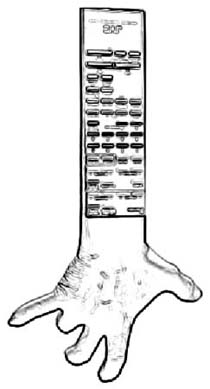| tec |
| | home | site map | about context | lang >>> español | |
| >>> context weblog | |
| technology > chips > implant | ||
|
october
30, 2000 |
|
digital angel, chip implant for humans | |
|
|
||
|
::
|
A
surveillance technology company Digital Angel is developed by Applied Digital Solutions. On December 15, 1999, licensed the technology from another company (on May 13, 1997, United States Patent Number 5,629,678 was granted for a "personal tracking and recovery system.") ADS is in the process of acquiring Destron Fearing, one of the main creators of the chips for animals. "We believe the potential global market for this device -- in all of its applications -- could exceed $100 billion dollar." Implantable in humans, with applications in e-business to business security, monitoring the medical condition of at-risk patients, tracking endangered wildlife or household pets, emergency location and criminal justice. Piezoelectric power supply technology For the first time in the history of location and monitoring technology, according to ADS, Digital Angel overcomes limitations of unwieldy size, maintenance requirements, insufficient or inconvenient power-supply and activation difficulties. "The transceiver's power supply and actuation system are unlike anything ever created. When implanted within a body, the device is powered electromechanically through the movement of muscles, and it can be activated either by the "wearer" or by the monitoring facility. A novel sensation feedback feature will even allow the wearer to control the device to some degree." Potential for abuse In the article *They can find you* by Kurt Kleiner from New Scientist, Emily Whitfield, a spokeswoman for the American Civil Liberties Union said "this kind of stuff has enormous potential for abuse by the authorities, or by anyone who can break into the information". She worries that the devices could become widespread, allowing governments to monitor their citizens. And she speculates that criminals could crack the codes needed to activate and use the devices, allowing them to pinpoint, say, potential kidnap victims." Before, in the brief *"Privacy in America: Electronic Monitoring"* ACLU denounced the coming of "active badges," clip-on microcomputers that allow an employer to track a worker's movements electronically. "Increasingly, members of the American workforce are being treated like pieces of equipment." Beyond: brain implants On October 26, 1998, a paralyzed man who received a *brain implant* - a neurotrophic electrode - become the first human to successfully control a computer using only his thoughts. This was the result of cognitive engineering being developed by neurosurgeon Dr. Roy Bakay, and his Emory University colleague, neurologist Dr. Philip Kennedy. This new technique has profound implications for paralyzed people everywhere. "The neurotrophic electrode is implanted into the motor cortex of the brain using a tiny glass encasing. Neurotrophic growth factors are implanted into the glass, and the cortical cells grow into the electrode and form neural contacts. It takes several weeks for the cortical tissue to grow into the electrode. The neurons in the brain transmit an electronic signal when they "fire." Recording wires placed inside the glass cone pick up the neural signals from the ingrown brain tissue and transmit then through the skin to a receiver and amplifier outside of the scalp. The system is powered by an induction coil placed over the scalp. There are no wires going through the skin. The recorded neural signals are connected to the computer and are used as a substitute for the mouse cursor. The patient is able to hear noises that indicate when his brain is thinking in a way that will allow him to focus on the cursor and move it. The trick is teaching the patient to control the strength and pattern of the electric impulses being produced in the brain," Dr. Bakay said. After some training, the patient is able to 'will' a cursor to move and then stop on a specific point on the computer screen." The vision of a cyborg In August 1998, Warwick was the first human to have a silicon chip implanted in their arm to test human-computer interaction. *Professor Kevin Warwick* envisions a world in which humans communicate directly with computers, and network continually with computers. In their article *Cyborg 1.0* (Wired, February 2000), Kevin Warwick outlines his plan to become one with his computer. Involves directly linking the human nervous system, via a radio frequency signal, with the electronic signals in a computer. What do we become when our movements, emotions and ultimately our thoughts are directly connected to computer technology? Can we link computer brains and human brains together to enhance our intelligence? Can we affect the way human's think and act, by means of electronics not chemicals - cyber drugs? Will it be possible for humans to communicate with each other by thought alone? |
|
 |
||
|
|
||
|
source::
|
Secretary
of Commerce, Norman Y. Mineta, to attend october 30th Digital Angel event
in New York City <http://www.adsx.com/ADSX/CDA/News/news_index/0,1136,552,00.html> :: related context they want their id chips now. february 6, 2002 <http://www.wired.com/news/print/0,1294,50187,00.html> :: references Applied Digital Solutions Acquires Rights to World's First Digital Device Implantable in Humans <http://biz.yahoo.com/bw/991215/fl_applied_2.html> They can find you by Kurt Kleiner from New Scientist <http://www.newscientist.com/ns/20000108/newsstory8.html> Privacy in America: Electronic Monitoring <http://www.aclu.org/library/pbr2.html> Emory neuroscientists use brain implant to help paralyzed and speech-impaired patients communicate via computer <http://www.emory.edu/WHSC/HSNEWS/releases/feb99/022399brain.html> Professor Kevin Warwick <http://www.cyber.rdg.ac.uk/K.Warwick/> Cyborg 1.0 <http://www.wirednews.com/wired/archive/8.02/warwick_pr.html> :: image The Human Body and the Machine <http://www.mit.edu:8001/afs/athena.mit.edu/course/4/4.395/www/rukide/ruki.html> |
|
|
|
||
| | home | site map | about context | lang > español | | ||
context weblog >>>
http://www.straddle3.net/context